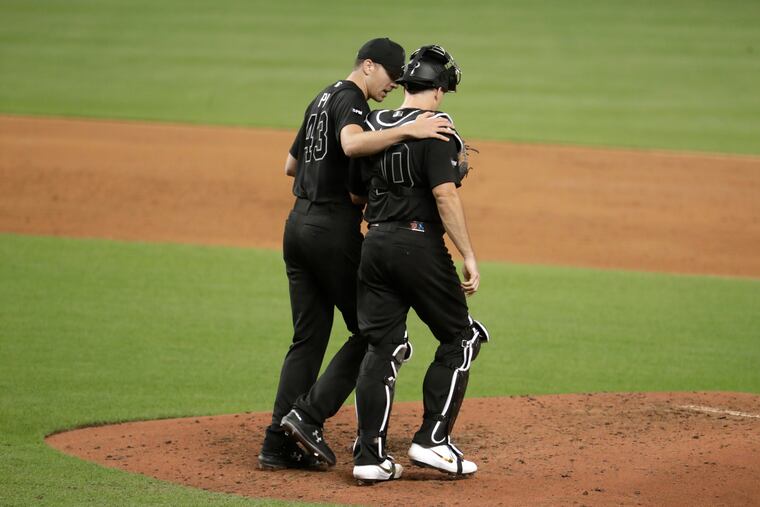The Phillies are where they are because they built a poor pitching staff. Period. | David Murphy
The fundamental problem with this Phillies team is not the managing, or the hustle, or the injuries, or the periodic hitting funks of its future star first baseman. The problem is pitching, going into battle with a rotation built largely on hopes and prayers.

Let’s do some math. Since joining the Braves rotation on June 21, veteran lefty Dallas Keuchel has pitched at least six innings while allowing three or fewer runs in nine of his 14 starts. During that same stretch, the Phillies’ entire rotation behind Aaron Nola has done it in eight of its 48 starts. This season, the Phillies are 34-16 in games in which a starter pitches at least six innings while allowing three or fewer runs. They are 37-49 in all other games.
All of that adds up to a 2.5 game deficit in the NL wild-card race, a number that has been the source of what amounts to a textbook case of victim-blaming on the part of people who have spent the summer pointing their fingers in the direction of Phillies manager Gabe Kapler. By this point, it should be as clear as a Category 5 eye wall that the fundamental problem with this Phillies team is not the managing, or the hustle, or the injuries, or the periodic hitting funks of its future star first baseman. The problem is pitching, the same as it was always going to be when the front office sent Kapler and his lineup into battle with a rotation built largely on hopes and prayers.
Take Keuchel, for instance. The point of the aforementioned series of statistics isn’t to suggest that the Phillies should have outbid the Braves for the services of the veteran lefty as he languished on the free agent market all spring. No doubt, they probably should have, at least if they were serious about giving the clubhouse a legitimate chance at reaching its potential. But we’ll save such hindsight for future columns. For now, the point of citing Keuchel’s performance is to illustrate just how different things could look if the Phillies could subtract one of their cocktail of underperforming starters and replace him with the sort of dependable start-to-start reliability that the front office pooh-poohed heading into the season.
For instance, take the Phillies’ win percentage in games where they got six-plus innings and three or fewer runs by a starter and their win percentage in other games and the numbers would suggest that they’d be about 8-6 in 14 starts by Keuchel. That might not sound great until you consider the fact that, since Keuchel’s debut on June 21, the Phillies are 3-10 in starts by Zach Eflin and 1-3 in starts by Nick Pivetta.
Granted, that sort of math wouldn’t hold up in a freshman-level data-analysis course, let alone a court of law. But it does provide some indication of where things would stand in a hypothetical world where the Phillies’ rotation featured another qualified starter behind Nola. They could easily be tied with the Chicago Cubs and within striking distance of the Washington Nationals. More importantly, they would give us some reason to watch the final 26 games of the season without the overpowering sense of doom that currently settles in around 7 each night.
That’s the frustrating part of this 2019 season, and it’s similar to the one Phillies fans experienced during the early-to-mid 2000s when Larry Bowa’s teams seemed stuck on 86 wins. As close as they might have looked on paper, in practice they never looked like they had a roster capable of reaching the heights by which the manager would be judged. They did not have a pitching staff, and all of the resources that had been devoted to the lineup were meaningless because of it.
The calculus is not complicated. When a team goes back-to-back games holding an opponent to two or fewer runs, it has a pretty good chance of winning back-to-back games. Witness the Phillies of Sunday and Monday. Conversely, when a team allows a combined 17 runs in back-to-back games, it has a pretty good chance of going 0-2. Witness the Phillies of Friday and Saturday.
When the Phillies swept the Cubs and won four straight games in mid-August, there was some thought that the team was finding its stride. Problem was, the team still had the same rotation, and the same bullpen backing it up. In 14 games since, they’ve allowed an average of five runs per game and, as a result, have won as many as they’ve lost. That’s just the way it goes on a team with four replacement-level starters and a bullpen that does not have the depth to withstand the inevitable injuries that occur during a 162-game season.
We’ve done this exercise before, but let’s hammer home the point and do it again. J.T. Realmuto has an OPS 28 points above his career average and is one shy of his career high in home runs. Jean Segura’s OPS is 16 points higher than it was last season. Bryce Harper’s OPS is 20 points lower than his career average, but he has 30 home runs and could easily finish the year with numbers equal to or better than those he posted in his final campaign with the Nationals. Rhys Hoskins’ OPS is 10 points lower than his career mark and 22 points higher than last season.
The bottom line is that the Phillies’ offense is underperforming only if you compare it to its ceiling. It has been plenty good enough to contend if backed by a pitching staff that does not consistently suck the life out of the building and all of those inside. If you are going to point a finger, that’s the only rational target.